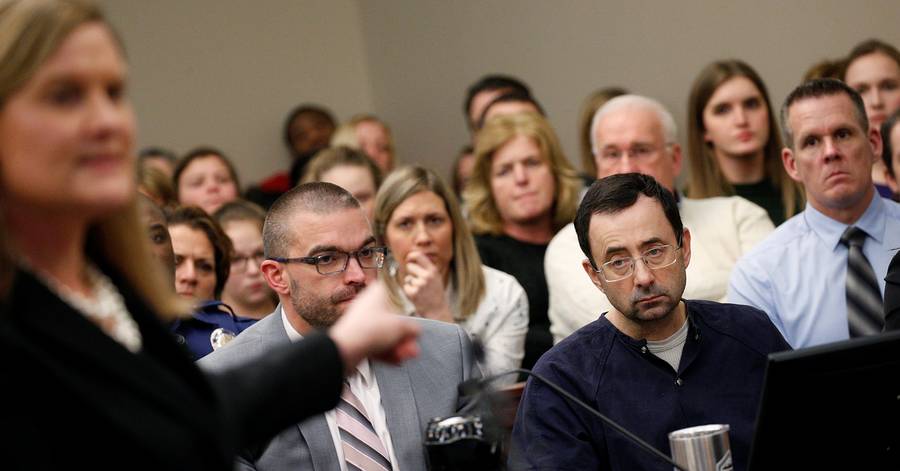This Day In History
Larry Nassar, a former doctor for USA Gymnastics, is sentenced to prison for sexual assault

Larry Nassar, a former doctor at Michigan State and for USA Gymnastics, is sentenced to 40 to 175 years in prison for sexual assault on January 24, 2018. Nassar was found guilty of using his position in sports medicine to abuse hundreds of women and girls in one of the most high-profile cases to arise from the #MeToo movement. The scandal resulted not only in his imprisonment, likely for the rest of his life, but also criticism of the institutions that failed to detect and respond to his behavior. In the wake of the revelations, the president of Michigan State and the entire board of USAG resigned, while Nassar’s accusers, which number over 260, received the Arthur Ashe Courage Award.
Nassar began working in sports medicine at a young age and began working as a trainer for the U.S. national gymnastics team in 1986. He later received his doctorate in osteopathic medicine from Michigan State and went on to work at the school’s College of Medicine as well as at the Karolyi Ranch, the Texas training center of the US gymnastics team. It was there that he sexually assaulted gymnast Maggie Nichols during a medical exam during a national team training camp in 2015. After a coach heard Nichols and another athlete discussing Nassar’s examinations, she reported the doctor to USAG. USAG contacted the Federal Bureau of Investigation but did not take immediate action against Nassar or notify his university.
Later that year, USAG cut ties with Nassar. A year later, in September 2016, the Indianapolis Star broke the news that two other gymnasts had accused him of sexual abuse, resulting in his firing from Michigan State. In November, Nassar was indicted on the charge of repeatedly abusing an unidentified child, beginning in 1998 when the child was six years old.
From there, the allegations snowballed. Three more athletes went public with their accusations on 60 Minutes in 2017, calling out the “emotionally abusive environment” at national team training camps. More came forward in subsequent interviews or using #MeToo on Twitter. Among the wave of accusers were several who had become household names for winning gold during the Rio 2016 Olympics, including McKayla Maroney, Aly Raisman, and Simone Biles. The involvement of athletes who had so recently been celebrated in the media further boosted the visibility of the Nassar case. All told, over 260 women have alleged that Nassar abused them, in many cases while they were still minors. An FBI raid found more than 37,000 images of child pornography in Nassar’s possession; he pleaded guilty to the possession charge in July of 2017.
The trials for Nassar’s other charges featured multiple days of testimony from his victims. He pled guilty to multiple allegations in Michigan state court, receiving a sentence of 40 to 175 years in prison, but will first serve a sentence of 60 years in federal prison for possession of child pornography.
In addition to Nassar’s convictions, the investigation brought scrutiny on the institutions that employed him. Reporting by the Star and other outlets found that USAG failed to adequately monitor its coaches and had knowingly refused to act on multiple allegations of abuse. At Michigan State, too, the problem proved to extend beyond Nassar. After allegations of repeated failure to investigate claims of assault against members of the football team, three players pled guilty to a lesser charge in a sexual assault case in 2018. The dean of the university’s school of osteopathic medicine, who oversaw Nassar’s clinic, was also charged with groping and possessing nude photos of a student.
A 2019 congressional report concluded that USAG, the university, the U.S. Olympic Committee, and even the FBI had all dragged their feet, allowing Nassar to continue to see patients as they slowly investigated and coordinated their response to the predicted public outcry. The university reached a settlement of $500 million with Nassar’s victims, the largest ever settlement of its kind, and former president Lou Anna Simon faces felony charges for lying to or misleading law enforcement regarding her knowledge of accusations against Nassar.
The Nassar case made international headlines. Nassar’s behavior and the failure of multiple institutions to protect his victims echoed many similar cases of serial abuse, such as Jerry Sandusky scandal at Penn State University or the decades of abuses committed by film producer Harvey Weinstein. The rapid expansion of the case from a few allegations to literally hundreds of women over multiple decades was a prime example of the power of the #MeToo movement. As with other cases brought to light in the #MeToo era, the Nassar case was both a sorely overdue reckoning with institutional abuse and a reminder that even the most prolific abusers can escape justice for decades.
Source: https://www.history.com/this-day-in-history/larry-nassar-usa-gymnastics-doctor-sentenced-prison-sexual-assault
This Day In History
Truman announces development of H-bomb

U.S. President Harry S. Truman publicly announces his decision to support the development of the hydrogen bomb, a weapon theorized to be hundreds of times more powerful than the atomic bombs dropped on Japan during World War II.
Five months earlier, the United States had lost its nuclear supremacy when the Soviet Union successfully detonated an atomic bomb at their test site in Kazakhstan. Then, several weeks after that, British and U.S. intelligence came to the staggering conclusion that German-born Klaus Fuchs, a top-ranking scientist in the U.S. nuclear program, was a spy for the Soviet Union. These two events, and the fact that the Soviets now knew everything that the Americans did about how to build a hydrogen bomb, led Truman to approve massive funding for the superpower race to complete the world’s first “superbomb,” as he described it in his public announcement on January 31.
On November 1, 1952, the United States successfully detonated “Mike,” the world’s first hydrogen bomb, on the Eniwetok Atoll in the Pacific Marshall Islands. The 10.4-megaton thermonuclear device, built upon the Teller-Ulam principles of staged radiation implosion, instantly vaporized an entire island and left behind a crater more than a mile wide. The incredible explosive force of Mike was also apparent from the sheer magnitude of its mushroom cloud–within 90 seconds the mushroom cloud climbed to 57,000 feet and entered the stratosphere. One minute later, it reached 108,000 feet, eventually stabilizing at a ceiling of 120,000 feet. Half an hour after the test, the mushroom stretched 60 miles across, with the base of the head joining the stem at 45,000 feet.
Three years later, on November 22, 1955, the Soviet Union detonated its first hydrogen bomb on the same principle of radiation implosion. Both superpowers were now in possession of the “hell bomb,” as it was known by many Americans, and the world lived under the threat of thermonuclear war for the first time in history.
Source: https://www.history.com/this-day-in-history/truman-announces-development-of-h-bomb
This Day In History
Gandhi assassinated

Mohandas Karamchand Gandhi, the political and spiritual leader of the Indian independence movement, is assassinated in New Delhi by a Hindu extremist.
Born the son of an Indian official in 1869, Gandhi’s Vaishnava mother was deeply religious and early on exposed her son to Jainism, a morally rigorous Indian religion that advocated nonviolence. Gandhi was an unremarkable student but in 1888 was given an opportunity to study law in England. In 1891, he returned to India, but failing to find regular legal work he accepted in 1893 a one-year contract in South Africa.
Settling in Natal, he was subjected to racism and South African laws that restricted the rights of Indian laborers. Gandhi later recalled one such incident, in which he was removed from a first-class railway compartment and thrown off a train, as his moment of truth. From thereon, he decided to fight injustice and defend his rights as an Indian and a man. When his contract expired, he spontaneously decided to remain in South Africa and launched a campaign against legislation that would deprive Indians of the right to vote. He formed the Natal Indian Congress and drew international attention to the plight of Indians in South Africa. In 1906, the Transvaal government sought to further restrict the rights of Indians, and Gandhi organized his first campaign of satyagraha, or mass civil disobedience. After seven years of protest, he negotiated a compromise agreement with the South African government.
In 1914, Gandhi returned to India and lived a life of abstinence and spirituality on the periphery of Indian politics. He supported Britain in the First World War but in 1919 launched a new satyagraha in protest of Britain’s mandatory military draft of Indians. Hundreds of thousands answered his call to protest, and by 1920 he was leader of the Indian movement for independence. He reorganized the Indian National Congress as a political force and launched a massive boycott of British goods, services, and institutions in India. Then, in 1922, he abruptly called off the satyagraha when violence erupted. One month later, he was arrested by the British authorities for sedition, found guilty, and imprisoned.
Source: https://www.history.com/this-day-in-history/gandhi-assassinated
This Day In History
U.S. Baseball Hall of Fame elects first members

On January 29, 1936, the U.S. Baseball Hall of Fame elects its first members in Cooperstown, New York: Ty Cobb, Babe Ruth, Honus Wagner, Christy Matthewson and Walter Johnson.
The Hall of Fame actually had its beginnings in 1935, when plans were made to build a museum devoted to baseball and its 100-year history. A private organization based in Cooperstown called the Clark Foundation thought that establishing the Baseball Hall of Fame in their city would help to reinvigorate the area’s Depression-ravaged economy by attracting tourists. To help sell the idea, the foundation advanced the idea that U.S. Civil War hero Abner Doubleday invented baseball in Cooperstown. The story proved to be phony, but baseball officials, eager to capitalize on the marketing and publicity potential of a museum to honor the game’s greats, gave their support to the project anyway.
In preparation for the dedication of the Hall of Fame in 1939—thought by many to be the centennial of baseball—the Baseball Writers’ Association of America chose the five greatest superstars of the game as the first class to be inducted: Ty Cobb was the most productive hitter in history; Babe Ruth was both an ace pitcher and the greatest home-run hitter to play the game; Honus Wagner was a versatile star shortstop and batting champion; Christy Matthewson had more wins than any pitcher in National League history; and Walter Johnson was considered one of the most powerful pitchers to ever have taken the mound.
Today, with approximately 350,000 visitors per year, the Hall of Fame continues to be the hub of all things baseball.
Source: https://www.history.com/this-day-in-history/u-s-baseball-hall-of-fame-elects-first-members
-

 NEWS2 years ago
NEWS2 years ago2 hurt, 1 jailed after shooting incident north of Nocona
-

 NEWS1 year ago
NEWS1 year agoSuspect indicted, jailed in Tia Hutson murder
-

 NEWS2 years ago
NEWS2 years agoSO investigating possible murder/suicide
-

 NEWS2 years ago
NEWS2 years agoWreck takes the life of BHS teen, 16
-

 NEWS2 years ago
NEWS2 years agoMurder unsolved – 1 year later Tia Hutson’s family angry, frustrated with no arrest
-

 NEWS2 years ago
NEWS2 years agoSheriff’s office called out to infant’s death
-

 NEWS2 years ago
NEWS2 years agoBowie Police face three-hour standoff after possible domestic fight
-

 NEWS2 years ago
NEWS2 years agoDriver stopped by a man running into the street, robbed at knifepoint







